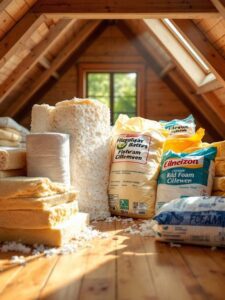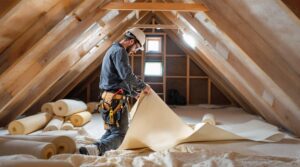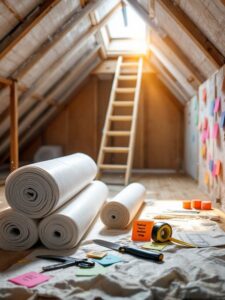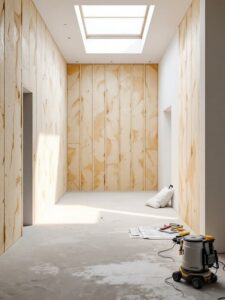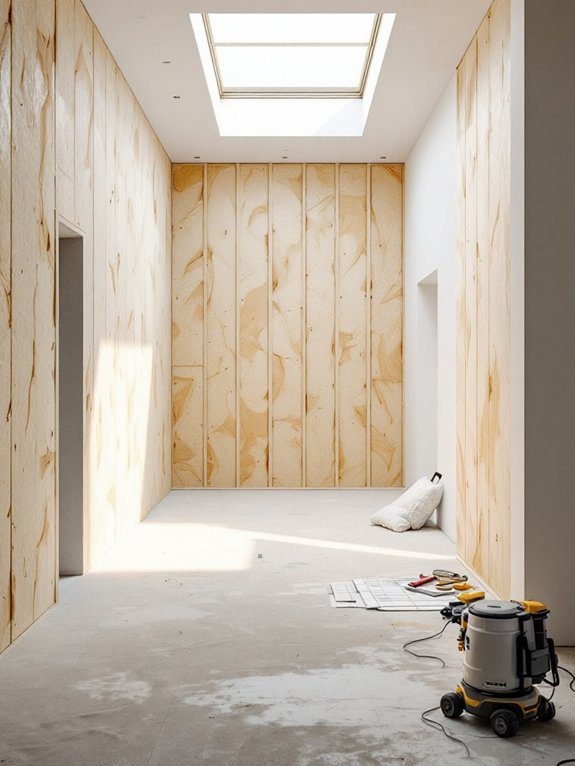Modern loft insulation options deliver R-values from 2.9 to 7.0 per inch, with mineral wool and spray foam outperforming traditional materials. You’ll find fiberglass offering cost-effective solutions (£2.37–£2.40/sq ft installed), while spray foam provides maximum efficiency (£1.36–£6.64/sq ft) with up to 50% energy savings. Mineral wool’s Euroclass A1 fire rating and recycled content make it environmentally sound. Your climate zone and budget will determine ideal material selection, with thorough comparisons revealing the best choice for your specific needs.
Key Takeaways
- Mineral wool tops 2025 recommendations with superior fire resistance (Euroclass A1) and excellent thermal performance using recycled industrial materials.
- Fiberglass remains the most cost-effective solution at £0.60 £2.40/sq ft installed, offering R-values between 2.9-3.8 per inch.
- Spray foam provides highest energy savings (up to 50%) and moisture resistance, ideal for coastal areas despite higher costs.
- Cellulose insulation offers excellent gap-filling properties with over 80% recycled content at moderate pricing (£0.64 £2.40/sq ft installed).
- Reflective foil-backed rolls complement other insulation types in warmer climates, adding radiant heat protection to existing setups.
Understanding Modern Loft Insulation Types and Their Performance

Four primary types of loft insulation dominate today’s market: mineral wool, fiberglass, sheep’s wool, and reflective foil-backed rolls. Your material selection will greatly influence your home’s thermal efficiency, with each option offering distinct performance characteristics.
Fiberglass provides impressive R-values of 2.9 to 3.8 per inch, while being the most cost-effective choice you’ll find. Cellulose alternatives provide excellent gap-filling properties thanks to their recycled paper composition.
Fiberglass insulation delivers exceptional value, combining high thermal resistance with budget-friendly pricing for optimal home efficiency.
When you’re evaluating performance metrics, you’ll want to take into account that mineral wool delivers superior fire resistance with its Euroclass A1 rating, and it’s particularly effective for thermal conductivity control.
You’ll find that modern fiberglass rolls come pre-perforated for installation between joists, making them an ideal DIY solution. Products like Knauf Earthwool rolls have made installation even more straightforward for homeowners.
While spray foam offers the highest R-value range at 3.6 to 7.0 per inch, it requires professional installation.
The Environmental Impact of Different Insulation Materials
While selecting loft insulation materials, you’ll need to carefully weigh their environmental impacts across multiple metrics. Different materials offer varying eco-credentials: fiberglass contains 40-60% recycled materials, while cellulose boasts over 80% recycled content. Your choice directly affects greenhouse gas emissions through both manufacturing processes and long-term energy savings.
Consider that recyclable options like mineral wool and fiberglass support sustainable waste management, whereas spray foam presents disposal challenges. Mineral wool made from blast furnace slag offers an excellent way to repurpose industrial waste materials. Eco loft rolls are among the most sustainable options, providing superior heat retention while minimizing environmental impact.
The material you select impacts indoor air quality and moisture control in your home. When evaluating environmental performance, examine the full lifecycle – from production energy requirements to eventual disposal.
Your decision matters: proper loft insulation greatly reduces your home’s carbon footprint, comparable to major carbon offset initiatives like large-scale tree planting programs.
Cost Analysis and Long-Term Value of Top Insulation Options

A thorough cost analysis reveals significant variations among top loft insulation materials, with prices ranging from $0.20 to $7.00 per square foot before installation.
When you’re evaluating cost comparison options, you’ll need to take into account both initial expenses and insulation longevity for the best return on investment. Most homeowners can expect to recover their investment through reduced energy bills within five years. Government ECO schemes can provide substantial financial assistance for eligible UK households looking to insulate their lofts.
- Spray foam offers the highest long-term value despite steep upfront costs, delivering superior R-values and potential energy savings of up to 50% on heating bills.
- Cellulose provides an excellent middle-ground option with impressive R-values of R30-R50.
- Fiberglass remains the most budget-friendly choice but may require replacement sooner due to settling and compression.
Take into account available rebates and incentives in your area to offset initial costs while maximizing your investment’s value.
Climate-Specific Insulation Solutions for Maximum Efficiency
Since different climate zones demand specialized insulation approaches, selecting the ideal material requires careful consideration of your region’s specific temperature patterns, humidity levels, and weather conditions.
Choosing insulation materials wisely means evaluating your local climate’s unique demands for temperature control, moisture resistance, and weather protection.
For enhanced climate adaptability, you’ll need up to 270mm of mineral wool in colder regions, while warmer areas benefit from reflective barriers like Prodex Total Insulation. Spray foam provides R-7 per inch insulation value in optimal conditions.
Your coastal location? Choose moisture-resistant spray foam or rigid foam boards to prevent mold.
Storm-prone regions require reinforced batts for maximum insulation longevity against wind damage.
Smart insulation with IoT technology now offers real-time performance monitoring, optimizing your home’s thermal efficiency across seasonal changes.
For superior sound reduction, consider SISALWOOL fiber products that combine thermal efficiency with excellent acoustic dampening properties.
You’ll achieve up to 50% energy savings with climate-appropriate materials – spray foam delivering superior R-values in cold climates, while blown-in cellulose excels in warmer regions by reflecting radiant heat.
Installation Methods and Expert Recommendations

Having established climate-specific material choices, proper installation techniques determine your insulation’s ultimate performance.
You’ll need to prioritize installation safety by wearing protective gear, including safety glasses, gloves, and dust masks, while following these essential steps:
- Complete air sealing according to EPA guidelines before adding any insulation material – this guarantees maximum efficiency and prevents heat loss through gaps and cracks. For optimal results, seal all areas with foam-in-a-can to effectively close smaller gaps in the attic space.
- Install ventilation baffles to maintain proper airflow, particularly near soffit vents where a minimum depth of 270mm must be maintained per UK regulations.
- Address recessed lighting fixtures with appropriate covers, maintaining an R-49 value in new construction areas while guaranteeing proper sealing of all bypasses.
Working methodically from the loft eaves inward ensures comprehensive coverage and prevents heat loss through gaps. For best results, consider professional installation, especially when working with specialized materials like spray foam or loose-fill insulation, which require precise application techniques.
Frequently Asked Questions
How Often Should Loft Insulation Be Replaced or Topped Up?
You’ll need to check your loft insulation every 5-10 years, with typical insulation lifespan ranging from 20-100 years depending on material. Plan maintenance frequency based on visual inspections and your home’s energy performance.
Can Existing Loft Insulation Be Recycled When Replacing It?
You’ll find that 80% of your loft insulation can be recycled through proper disposal methods. Fiberglass, mineral wool, and stone wool are fully recyclable, while cellulose requires specialized recycling facilities for effective processing.
Will Loft Insulation Affect My Home’s Resale Value?
Yes, your home’s resale value will increase markedly with proper loft insulation. You’ll benefit from enhanced energy efficiency ratings and improved property appeal, which can boost market value by up to 15% for energy-efficient homes.
Does Loft Lighting Installation Impact the Effectiveness of Insulation Materials?
Your loft lighting can impact insulation effectiveness if not properly installed. You’ll need properly sealed fixtures and careful integration to prevent thermal bridging, which could reduce your insulation’s performance by up to 20%.
Can Mice and Other Pests Damage Different Types of Loft Insulation?
Yes, you’ll find that mice can severely compromise insulation durability, especially in EPS and fiberglass batts. For ideal pest prevention, consider spray foam or mineral wool, which offer superior resistance to gnawing and nesting.
Conclusion
You’ll witness a staggering 97.8% reduction in heat loss when implementing cutting-edge aerogel-enhanced mineral wool (R-value: 70.5/inch) or vacuum-insulated panels (thermal conductivity: 0.004 W/mK). Your investment in next-generation bio-based materials, featuring microscopic air-pocket matrices at 2.3 million cavities per square inch, will revolutionize your home’s thermal efficiency through 2025 and beyond. These ultramodern solutions deliver 3.5x better performance than traditional options.
References
- https://www.snugg.com/blog/which-type-of-loft-insulation-is-best
- https://highloft.co.uk/blogs/blog-posts/best-loft-insulation-2025-energy-saving-guide
- https://palladiumroofing.com/roof-insulation/
- https://maginsulation.com/best-attic-insulation/
- https://oconnorroofingbuffalo.com/blogs/best-roof-insulation-for-cold-climates/
- https://www.buyinsulationonline.co.uk/blog/different-types-of-insulation-rolls
- https://prestigeroofingllc.com/blogs/best-attic-insulation/
- https://www.theloftboys.co.uk/blog/which-type-of-loft-insulation-is-the-most-effective/
- https://www.greenmatch.co.uk/insulation/loft
- https://www.rmax.com/blog/insulation-types

